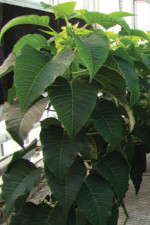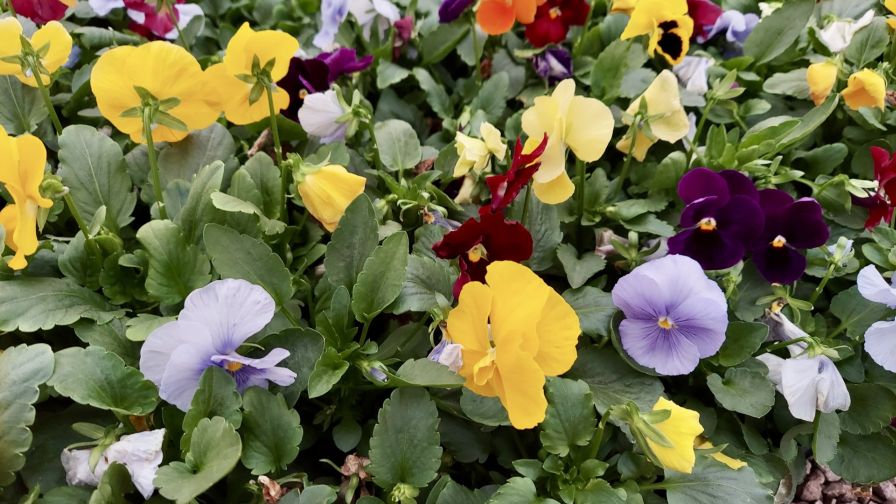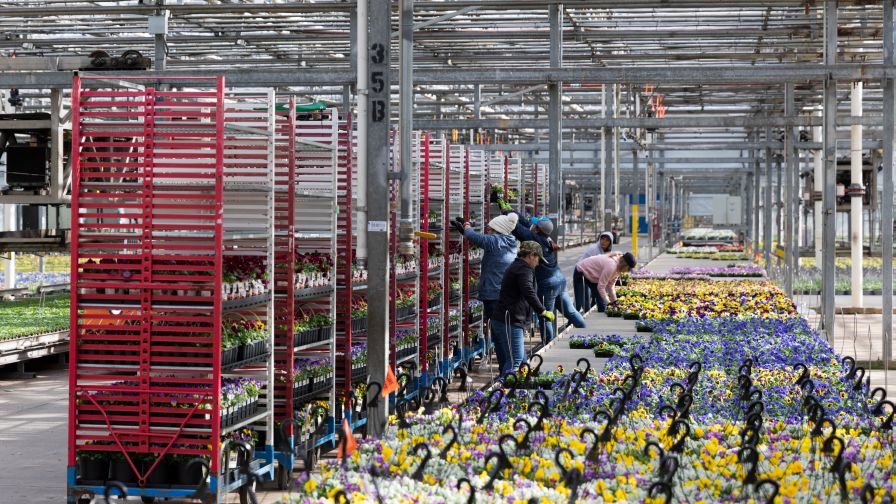The Potential Of Poinsettia Trees

Tree form poinsettias offer a sales opportunity to a new generation of consumers that does not associate the traditional potted 6-inch poinsettia with the Christmas holiday. Young adult consumers are more likely to be interested in non-traditional novelty cultivars and poinsettias used as an interesting form or as color in a mixed combination planter.
In other words, consumers are interested in poinsettias as a design element versus a traditional holiday purchase. Tree form poinsettias have been produced for many years as a high-end item for retail sales, primarily for offices and businesses. For three- to five-foot trees, varieties such as ‘Peterstar,’ ‘Prestige,’ ‘Snowcap,’ the Christmas Angel series, the Classic series, ‘Independence’ and ‘Infinity Red’ have been used. They have strong stems and large bracts.
For the more recent miniature or tabletop trees (up to 18 inches tall), cultivars such as those in the Premium series, ‘Strawberries N’ Cream,’ ‘Enduring’ and ‘Winter Rose’ have been used due to their more compact growth habits.
The Trial
In 2009 and 2010, we trialed several new, as well as older cultivars, of various genetics at Purdue University to assess their growth, stem breakage and commercial production ability as tree form or tabletop poinsettias. We also wanted to determine potential marketability and consumer interest in these premium novelty plants.
Cultivars were chosen based on potential consumer interest in bract color and successful growing experience under our conditions in each respective season. With no previous experience in growing tree form poinsettias and selecting cultivars of multiple height and response groups, we did not limit the trial to only cultivars that should have worked.
Rooted cuttings of each cultivar were transplanted into 6-inch standard pots in an 80 percent peat, 20 percent perlite substrate and fertilized every watering with 200 ppm nitrogen through an automated drip irrigation system. (The Ecke Poinsettia Manual indicates rooted cuttings should be transplanted by week 26; week 22 for larger trees.)
Fungicide drenches (rotation between FRAC classes) were applied monthly, as they should be for a typical poinsettia crop. Average daily temperature in the greenhouse was 71°F in 2009 and 68°F in 2010. Side shoots low on the stem were removed when 1 to 2 inches long, beginning approximately two weeks after transplant. This was done on a weekly basis as necessary. It was the most labor intensive aspect of production.
Gibberellic acid (GA3) was applied as a 50-ppm spray about four weeks after transplant to increase stem elongation for desired height and stem diameter for sturdiness. Plants were then pinched in mid-August to assure at least six good breaks. As a result of GA3 applications, lower leaves were nearly twice their usual size (Figure 1). Lower leaves are typically not removed until late September or early October to allow for maximum photosynthesis.
At our site, blackout cloth was pulled manually beginning in mid-October, regardless of response group, due to space restraints for this trial. Paclobutrazol drenches were applied in September and October to avoid any undesirable stretch. We experienced the usual fungus gnat and whitefly issues associated with growing poinsettias in 6-inch pots.
In 2009, cuttings were transplanted before week 22, resulting in large trees requiring considerably more labor and spacing (nearly four to six square feet per plant by late October) (Figure 2). There was additional labor involved with repotting that was challenging with large tree form poinsettias that is not recommended! Staking and stem support would have been an additional labor input had we needed to “ship” our plants further than down the hall.
2009 Results
Logistical concerns aside, we experienced success with all cultivars in 2009. As might be expected, the more vigorous cultivars are fairly easy to grow and may require aggressive PGR applications to keep them in check–not just the late drenches used in this trial. ‘Christmas Feelings Cinnamon,’ ‘Whitestar,’ and ‘Maren’ fall in this category. Some of the ‘Carousel Dark Red’ trees experienced stem breakage, and there was some stem splitting with ‘Eggnog.’ We produced only six to eight trees of each cultivar for only one season, so we cannot deduce how large a problem this might be from year to year.
From the approximately 250 attendees at our 2009 consumer open house, we solicited their three favorite poinsettia trees out of the seven on display (Figure 3). Twenty-seven percent of participants selected ‘Silverstar Red’ and 22 percent ‘Maren’ as their favorite trees (Figure 4). Sixty-nine percent of those consumers indicated they would be willing to pay between $50 and $55 for these poinsettia trees.
Considering there is approximately a 25- to 28-week production period involved in producing large trees, plus the extra labor involved in staking, side shoot and lower leaf removal, it would likely be very difficult to turn a profit unless you have customers willing to pay top dollar for such items.
These trees are, however, spectacular in this size and surprisingly resilient and long lasting. If contract grown for December events in the array of colors now available, they speak beyond the Christmas holiday and are a very versatile design element.
2010 Results
In 2010, we decided to go smaller, so we started closer to week 26. Again, we were able to successfully produce tree forms out of all cultivars trialed. ‘Christmas Angel Marble, ‘Cortez Burgundy’ and ‘Wintersun’ became too large for the 6-inch standard container in which we had intended to finish the crop–even with two late plant growth regulator drenches.
| Table 1. Cultivars trialed in tree form in 2009 and 2010 at Purdue University | |||
| 2009 Tree Poinsettia (4 Feet) | 2010 Tree Poinsettia (2 to 3 Feet) | ||
| Breeder | Cultivar | Breeder | Cultivar |
| Syngenta | ‘Carousel Dark Red’ | Selecta | ‘Candy Pink’ |
| Selecta | ‘Christmas Feelings Cinnamon’ | Selecta | ‘Christmas Angel Marble’ |
| Ecke | ‘Eggnog’ | Syngenta | ‘Cortez Burgundy’ |
| Ecke | ‘Maren’ | Ecke | ‘Polly’s Pink’ |
| Dummen | ‘Premium Red’ | Dummen | ‘Premium Picasso Dark’ |
| Syngenta | ‘Silverstar Red’ | Ecke | ‘Tapestry’ |
| Syngenta | ‘Whitestar’ | Selecta | ‘Wintersun’ |
About one third of the ‘Cortez Burgundy’ trees had split bracts. ‘Premium Picasso Dark’ and ‘Tapestry’ were most easily kept to an appropriate size (24 inches in height), but both needed a few weeks longer in the greenhouse for good bract coloration than the other cultivars.
In 2010, we offered staff within the horticulture department a free poinsettia tree from the selection we had. ‘Candy Pink’ and ‘Polly’s Pink’ were not as readily chosen, with red and burgundy bract cultivars being the most desired. The consumer open house in 2009 included younger consumers who are attracted to unique, bright colors over traditional tones.
An interesting observation among the staff comments and selections was the desire for tabletop, or in this case, “desktop” sizes. As showy and beautiful as 2- to 3-foot trees are, practical considerations among consumers indicate the best market may be in the miniature trees (less than 2 feet), which are easy to carry and transport in a vehicle, fit nicely on a desk or work station and have the traditional showiness of potted flowering plants–with the added drama of a topiary.
Careful cultivar selection and early PGR application would be the main components of miniature tree production. Ecke Ranch and Selecta both include suggestions for cultivars suitable for tree form on their websites. Compact varieties with early response times would appear to be the best candidates for economically viable miniature tree production. Although our trials did not involve data on production economics, future trials should include this data. As with any new production method, always trial new cultivars on a small scale.










